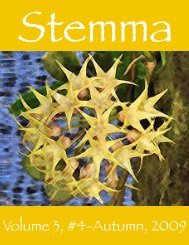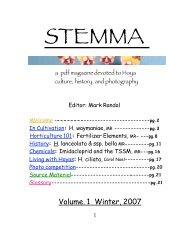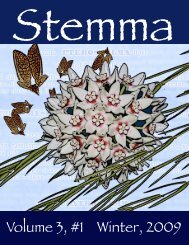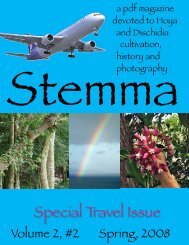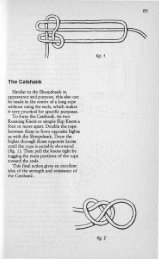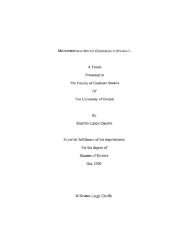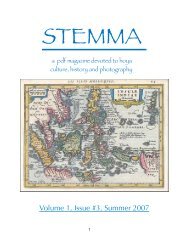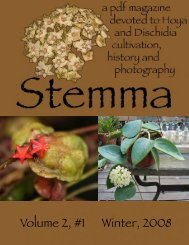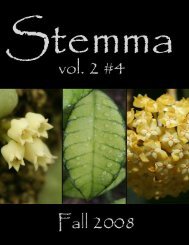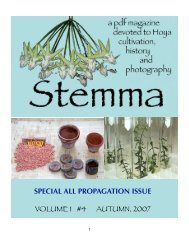Volume 3, Issue #2 - Cubits
Volume 3, Issue #2 - Cubits
Volume 3, Issue #2 - Cubits
You also want an ePaper? Increase the reach of your titles
YUMPU automatically turns print PDFs into web optimized ePapers that Google loves.
Appendix A<br />
Technical discussion of the validity<br />
of the re-ranking of genus<br />
Eriostemma (Schltr.) D. Kloppenburg & Gilding.<br />
by Mark Randal<br />
In looking at this publication only one serious problem which may affect the validity of the publication of genus<br />
Eriostemma is obvious: the individual species transfer data (except for Hoya coronaria) do not explicitly state the<br />
basionym form of each species name. This point was suggested by Christine Burton in P. S. The Hoyan V.4,#4 and<br />
also indicated in Flora Malesiana Bulletin Vol. 13(1) in the following way: “15 new comb, all invalid (Art. 33.3:<br />
basionyms not mentioned, only referred to!; see also Fraterna 14/1 (2001)”.<br />
This point does not actually agree with the rules of the ICBN, and this view is not supported by the IPNI (International<br />
Plant Name Index) which, while not infallible, does research the names listed therein and notes invalid<br />
names/combinations.<br />
The relevant Article (33.4) of the ICBN states:<br />
"On or after 1 January 1953, a new combination, a new generic name with a basionym, or an avowed substitute<br />
(replacement name, nomen novum) based on a previously and validly published name is not validly published<br />
unless its basionym (name-bringing or epithet-bringing synonym) or the replaced synonym (when a new<br />
name is proposed) is clearly indicated and a full and direct reference given to its author and place of valid publication,<br />
with page or plate reference and date (but see Art. 33.5 and 33.7).<br />
On or after 1 January 2007, a new combination, a new generic name with a basionym, or an avowed substitute<br />
is not validly published unless its basionym or replaced synonym is cited. "<br />
The requirement here states that before 2007 a new combination may be published by “clearly indicating” the<br />
basionym, rather than explicitly citing the basionym, so long as the basionym author and place of publication are<br />
correctly cited. This point is illustrated in example 13 for Article 33.4:<br />
"Ex. 13. The new combination Conophytum marginatum subsp. littlewoodii (L. Bolus) S. A. Hammer (Dumpling &<br />
His Wife: New Views Gen. Conophytum: 181. 2002), being made prior to 1 January 2007, was validly published<br />
even though Hammer did not cite the basionym (Conophytum littlewoodii) but only indicated it by citing its bibliographic<br />
reference. "<br />
As this instance parallels the situation for D. Kloppenburg & Gilding’s Eriostemma species transfers almost exactly<br />
(they all correctly cite basionym author and publication, except as noted below), it seems that the code<br />
would recognize the new Eriostemma species as being validly published.<br />
So this point does not preclude valid publication of Eriostemma as a genus.<br />
There are problems which preclude the valid transfer of two Eriostemma species from the genus Hoya:<br />
Eriostemma guppyi (the author citation is incorrect.)<br />
Eriostemma lauterbachii (the bibliographical citation is incorrect.)<br />
Also:<br />
Eriostemma pulgarensis is rendered invalid, since the basionym, Hoya pulgarensis, is itself not a validly published<br />
name.<br />
Two Eriostemma species (treated at the time as Hoya species- H. hollrungii and H. velutina) were placed into<br />
synonymy under Hoya coronaria by Kleijn & van Donkelaar (2001). This does not reflect the view of most botanists<br />
studying this group today; more study and potential republishing are necessary to clarify the standing of these<br />
potential species, but the names E. hollrungii and E. velutina now stand technically as synonyms of E. coronaria.<br />
n<br />
32



